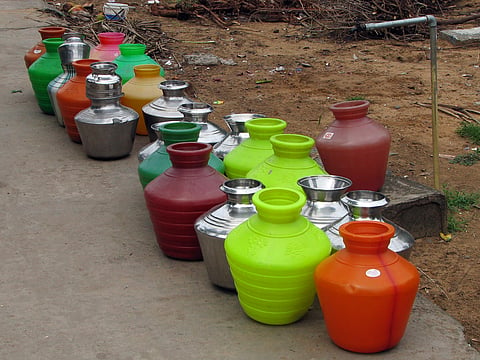
- Topics
- Feature
- Opportunities & Events
- About
- Hindi Portal
- Data
- Topics
- Feature
- Opportunities & Events
- About
- Hindi Portal
- Data

Access to water in Mumbai continues to be inequitable
Water access in Mumbai remains a serious challenge with slum residents bearing the brunt of unreliable supply, low pressure, and limited hours. Around two million people depend on alternate sources, sometimes receiving as little as 20 litres per capita per day.
However, Mumbai is not a water scarce city—it suffers from mismanagement. Despite having sufficient resources, water is unevenly distributed. In their paper ‘Taming’ a wicked problem: Selective problematisation of issues of urban water supply in Mumbai’, published in the Journal of Asian and African Studies, Sachin Tiwale and Subodh Wagle argue that the city’s water issues are complex and multidimensional without simplistic solutions.
Mumbai’s water supply: A web of socioeconomic and political challenges
Water supply in Mumbai depends on multiple factors having divergent interests that include engineers, planners, consultants, financial institutions, plumbers, elected representatives, political leaders, non-government organisations, upper class and the dominant middle class.
Mumbai’s water distribution is influenced by multiple factors, including land tenure, informal housing policies, and class-based inequities. Poverty, migration, and the expansion of informal settlements further impact access to water. The existing water distribution network in Mumbai is old, leaky, deteriorated, unmapped with haphazard planning and several cross-connections, making it difficult to maintain leading to several operation and management issues.
However, while these water supply issues cannot be solved through technological fixes alone, they continue to be chiselled and presented as a tame problem at the policy level – that which can be solved simplistically by increasing water quantity through increasing water resources.
Policy-level blind spots: Prioritising dams over distribution
An analysis of regional plans and an appraisal report of Phase II of the Bombay Water Supply and Sewerage Project (BWSSP), the largest project implemented by the water supply department of BMC to augment the water supply of the city in collaboration with the World Bank, reveal this attitude, argue the authors.
In 1974, the Bombay Metropolitan Region Planning Board (1974) released the first regional plan that assessed the total quantity of water supplied, total water demand and per capita availability of water in Mumbai and recommended 341 lpcd to cover all water uses, which was very high for Mumbai. However, the plan did not discuss the status of the existing water supply within the city and issues related to water distribution such as service coverage, access, leakages and inequity, point out the authors.
The Staff Appraisal Report prepared by the World Bank to justify Phase II of BWSSP focuses on getting an extra 455 million litres per day (MLD) water for Mumbai from the Bhatsa dam. While planning for the BWSSP project, the planners had included activities to improve the performance of the distribution network at the insistence of the World Bank experts. However, these activities were removed when BWSSP encountered cost escalation and went for mid-course redefinition, inform the authors.
The need for smarter water management
The regional plan for Mumbai Metropolitan Region (MMR) (2016–36) that was released in 2021 fails to acknowledge the issues of the water distribution network that adversely affect water access across all municipal councils and corporations of the MMR region.
Thus, water provision in the city gets converted into a one dimensional problem related to water shortages and solutions proposed are development of new water resources for the city and metropolitan region.
Sachin Tiwale, Fellow, Water and Society Programme, Centre for Environment and Development, Ashoka Trust for Research in Ecology and the Environment and the author of the paper argues, “The primary challenge with the water supply in Mumbai is managing water in the distribution network. There is no shortage of water at the city level. The data shows that in the last six decades, the city-level water availability has always been more than 250 lpcd. As per the regional plan of the Mumbai Metropolitan Region released in 2021, the city is supplied with 252 lpcd, excluding water for industrial use. This water is sufficient to meet the current water demand. However, the challenge is to distribute this water equitably across the city”.
He adds on that, “The priority should be for the Brihanmumbai Municipal Corporation to assess the water supply challenges using more realistic numbers to quantify the requirements of citizens of varied socio-economic statuses by conducting extensive consumer surveys. By reducing water losses, Mumbai can save water and potentially avoid (or postpone) constructing expensive dams and desalination of plants”
Indeed, there are a number of ongoing and proposed water resources development projects in the pipeline in Mumbai that include the Pinjal and Gargai dams and the Damanganga–Pinjal link project, that will bring an additional 2052 MLD water for Mumbai by constructing two dams and tunnels to bring water from Gujarat. The Brihanmumbai Municipal Corporation is also making plans to build a desalination plant.
Mumbai does not need more dams—it needs better water management. The city receives over 250 lpcd, which is sufficient to meet current demand. The focus should be on repairing the aging distribution network, reducing water losses, and ensuring equitable access with practical, cost-effective solutions over expensive, environmentally disruptive projects.